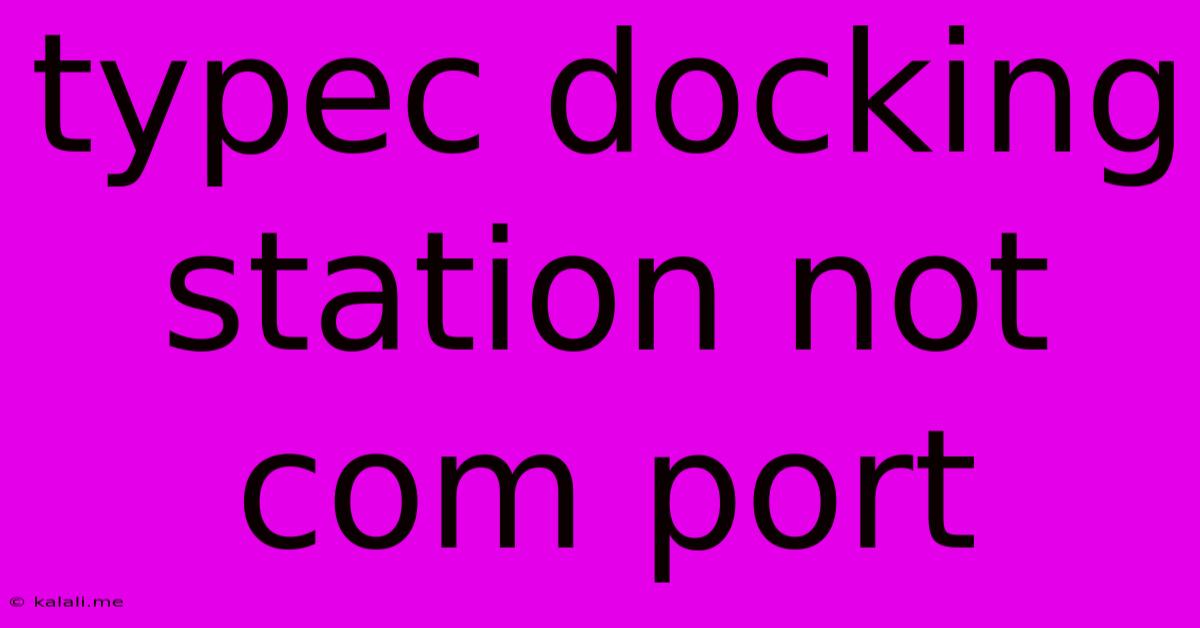Typec Docking Station Not Com Port
Kalali
May 23, 2025 · 4 min read

Table of Contents
Type-C Docking Station Not Showing COM Port: Troubleshooting Guide
Are you experiencing frustration because your new Type-C docking station isn't displaying the expected COM port in your device manager? This is a common issue that can stem from several different causes. This guide will walk you through troubleshooting steps to identify and resolve the problem, getting your serial communication up and running. Understanding the underlying reasons will help you avoid similar issues in the future.
Understanding the Problem: A COM port (serial communication port) is crucial for connecting to devices that use serial communication protocols, such as older peripherals, industrial equipment, or specialized sensors. When a Type-C docking station fails to expose a COM port, it means your computer isn't recognizing the serial communication capabilities, preventing these devices from functioning correctly.
Possible Causes and Solutions:
Several factors could prevent your Type-C docking station from recognizing the COM port. Let's examine the most common culprits and how to fix them:
1. Driver Issues: The Most Likely Culprit
- Problem: Incorrect, outdated, or missing drivers are the most frequent reason for COM port issues. Your operating system needs the correct drivers to recognize and utilize the serial communication capabilities of the docking station.
- Solution:
- Check Device Manager: Open Device Manager (search for it in the Windows search bar). Look for "Ports (COM & LPT)," expand the section, and check for any unknown devices or devices with error flags.
- Update Drivers: If you find any problematic devices, right-click and select "Update driver." Choose "Search automatically for drivers." If this doesn't work, you may need to download the latest drivers from the docking station manufacturer's website. Make sure you download the correct driver for your specific operating system (Windows 10, Windows 11, macOS, etc.).
- Reinstall Drivers: If updating fails, try uninstalling the driver completely and restarting your computer. Windows will often automatically reinstall the driver upon reboot. If not, repeat the update driver process.
- Check for BIOS Updates: In rare cases, outdated BIOS firmware can interfere with driver recognition. Check your motherboard manufacturer's website for BIOS updates. Proceed with extreme caution when updating your BIOS.
2. Incorrect Docking Station Configuration
- Problem: Some docking stations require specific settings to enable serial communication. This is often controlled through the docking station's own settings (either through software or physical switches).
- Solution: Consult your docking station's user manual. It should provide information on how to configure serial port settings, including enabling the COM port functionality. Look for jumper settings, DIP switches, or software configuration options.
3. Hardware Failure
- Problem: In unfortunate cases, the issue might be due to a hardware malfunction within the docking station itself. This is less common but can occur due to physical damage or manufacturing defects.
- Solution:
- Try a Different Docking Station: If possible, test your serial device with a different Type-C docking station to rule out a problem with your current one.
- Check Cables and Connections: Ensure that all cables are securely connected both to the docking station and your computer. Try using different cables if possible.
- Contact Support: If you've exhausted other options, contact the manufacturer of your docking station for support or warranty service.
4. Power Delivery Issues
- Problem: Insufficient power delivery from the Type-C port could prevent the docking station from functioning correctly, impacting its ability to expose the COM port.
- Solution:
- Use a Higher-Powered Adapter: Make sure you're using a power adapter that meets or exceeds the power requirements of the docking station. A low-power adapter might not provide enough power for all functions.
- Try a Different USB-C Port: Try connecting the docking station to a different USB-C port on your computer. Some ports may deliver more power than others.
5. Operating System Compatibility
- Problem: While less common with modern docking stations, incompatibility between the docking station and your operating system could be a factor.
- Solution: Check the manufacturer's website for operating system compatibility information. If your OS isn't explicitly supported, you may need to update your OS or explore alternative solutions.
By systematically working through these troubleshooting steps, you should be able to identify the root cause of the COM port issue with your Type-C docking station and restore serial communication functionality. Remember to always consult your docking station's user manual for specific instructions and support information.
Latest Posts
Latest Posts
-
How To Remove Kwikset Deadbolt From Door
May 23, 2025
-
How To Write Something Using Quotes Identifying Sarcasm
May 23, 2025
-
Is Oz The Great And Powerful Canon
May 23, 2025
-
Connecting Second Story Deck Post Joint
May 23, 2025
-
Can Number Fields Be Replaced By Function Fields
May 23, 2025
Related Post
Thank you for visiting our website which covers about Typec Docking Station Not Com Port . We hope the information provided has been useful to you. Feel free to contact us if you have any questions or need further assistance. See you next time and don't miss to bookmark.